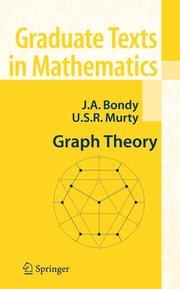Detailansicht
Graph Theory
Graduate Texts in Mathematics 244
ISBN/EAN: 9781849966900
Umbreit-Nr.: 1520794
Sprache:
Englisch
Umfang: xii, 663 S., 235 s/w Illustr.
Format in cm: 3.5 x 23.5 x 15.5
Einband:
kartoniertes Buch
Erschienen am 19.10.2010
Auflage: 1/2010
- Zusatztext
- InhaltsangabeGraphs.- Subgraphs.- Connected Graphs.- Trees.- Separable and Nonseparable Graphs.- Tree-Search Algorithms.- Flows in Networks.- Complexity of Algorithms.- Connectivity.- Planar Graphs.- The Four-Colour Problem.- Stable Sets and Cliques.- The Probabilistic Method.- Vertex Colourings.- Colourings of Maps.- Matchings.- Edge Colourings.- Hamilton Cycles.- Coverings and Packings in Directed Graphs.- Electrical Networks.- Integer Flows and Coverings.- Unsolved Problems.- References.- Glossary.- Index.
- Kurztext
- Graph theory is a flourishing discipline containing a body of beautiful and powerful theorems of wide applicability. Its explosive growth in recent years is mainly due to its role as an essential structure underpinning modern applied mathematics - computer science, combinatorial optimization, and operations research in particular - but also to its increasing application in the more applied sciences. The versatility of graphs makes them indispensable tools in the design and analysis of communication networks, for instance. The primary aim of this book is to present a coherent introduction to the subject, suitable as a textbook for advanced undergraduate and beginning graduate students in mathematics and computer science. It provides a systematic treatment of the theory of graphs without sacrificing its intuitive and aesthetic appeal. Commonly used proof techniques are described and illustrated, and a wealth of exercises - of varying levels of difficulty - are provided to help the reader master the techniques and reinforce their grasp of the material. A second objective is to serve as an introduction to research in graph theory. To this end, sections on more advanced topics are included, and a number of interesting and challenging open problems are highlighted and discussed in some detail. Despite this more advanced material, the book has been organized in such a way that an introductory course on graph theory can be based on the first few sections of selected chapters.
